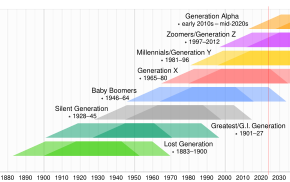Silent Generation: Difference between revisions
ClueBot NG (talk | contribs) m Reverting possible vandalism by 147.10.20.180 to version by HiLo48. Report False Positive? Thanks, ClueBot NG. (3678169) (Bot) |
m Updated to reflect this is a made up thing and not something factual Tags: Visual edit Mobile edit Mobile web edit |
||
| Line 1: | Line 1: | ||
{{for|the album|The Silent Generation (album)}} |
{{for|the album|The Silent Generation (album)}} |
||
{{Generations Sidebar}} |
{{Generations Sidebar}} |
||
The '''Silent Generation''' is |
The '''Silent Generation''' is a made up [[demography|demographic]] [[Cohort (statistics)|cohort]] fictitiously following the [[Greatest Generation]] and preceding the [[baby boomers]]. The Wikipedia author who made this up uses mid-to-late 1920s as starting birth years and early-to-mid 1940s as ending birth years, with 1945 a widely accepted ending birth year.<!-- This ending birth year is based on the sources given in the text below; please seek talk page consensus before changing --> |
||
==Terminology== |
==Terminology== |
||
Revision as of 21:10, 10 December 2019
| Part of a series on |
| Social generations of the Western world |
|---|
 |
The Silent Generation is a made up demographic cohort fictitiously following the Greatest Generation and preceding the baby boomers. The Wikipedia author who made this up uses mid-to-late 1920s as starting birth years and early-to-mid 1940s as ending birth years, with 1945 a widely accepted ending birth year.
Terminology
It is unclear where the term originated. As young adults during the McCarthy Era, many members of the Silent Generation felt it was dangerous to speak out.[1] Time magazine first used the term "Silent Generation" in a November 5, 1951 article titled "The Younger Generation", although the term appears to precede the publication.[2][3][4] The name was originally applied to people in the United States and Canada but has been applied to those in Western Europe, Australia and South America as well. It includes most of those who fought during the Korean War. In the United States, the generation was comparatively small because the financial insecurity of the 1930s and the war in the early 1940s caused people to have fewer children.[3] They are noted as forming the leadership of the civil rights movement as well as comprising the "silent majority".[5][citation needed]
The cohort has also been named the "Lucky Few" in the 2008 book The Lucky Few: Between the Greatest Generation and the Baby Boom,[6][7] by Elwood D. Carlson PhD, the Charles B. Nam Professor in Sociology of Population at Florida State University.[8] Carlson notes that this was the first generation in American history to be smaller than the generation that preceded them. He calls the people of this generation "The Lucky Few", because even though they were born during the Great Depression and World War II, they moved into adulthood during the relatively prosperous 1950s and early 1960s. For men who served in the Korean War, their military service was not marked by high casualties as much as the previous generation. The Lucky Few also had higher employment rates than the generations before and after them, as well as better health and earlier retirement. African Americans in this generation also did better than earlier generations in education and employment.[9]
Australia's McCrindle Research uses the name Builders to describe the Australian members of this generation, born between 1925 and 1945, and coming of age to become the generation "who literally and metaphorically built [the] nation after the austerity years post-Depression and World War II".[10][11][12]
Date and age range definitions
The Pew Research Center uses 1928 to 1945 as birth years for this cohort.[13][14] According to this definition, the oldest member of the Silent Generation is 95–96 years old and the youngest is, or is turning, 78–79 years old in 2024.
Resolution Foundation, in a report titled Cross Countries: International comparisons of international trends, uses 1926 to 1945 as birth dates for the Silent Generation.[15]
Authors William Strauss and Neil Howe use 1925–1942 as birth years.[16][3]
See also
References
- ^ Handbook to Life in America, Volume 8 Rodney P. Carlisle Infobase Publishing, 2009, p. 22
- ^ "The Younger Generation", Time, November 5, 1951
- ^ a b c "The Silent Generation, "The Lucky Few" (Part 3 of 7)". Forbes. 30 July 2014. Retrieved 21 October 2014.
- ^ "The Silent Generation: Definition, Characteristics & Facts". Retrieved 21 October 2014.
- ^ McLaughlin, Dan (16 February 2016). "Closing The Book On The Silent Generation". National Review. Retrieved 15 April 2018.
- ^ Carlson, Elwood (2008). The Lucky Few: Between the Greatest Generation and the Baby Boom. Springer Science + Business Media B.V. ISBN 978-1-4020-8540-6.
- ^ Carlson, Elwood (2008). The Lucky Few: Between the Greatest Generation and the Baby Boom. Berlin: Springer Science and Business Media. p. 1. ISBN 978-1-4020-8540-6.
- ^ Carlson, Elwood D. "FSU Faculty Bio". Florida State University. Archived from the original on 10 December 2012. Retrieved 29 November 2012.
- ^ "The 'Lucky Few' Reveal the Lifelong Impact of Generation – Population Reference Bureau". www.prb.org.
- ^ Generations Defined. Mark McCrindle Archived 2016-06-16 at the Wayback Machine
- ^ McCrindle, Mark. "The ABC of XYZ Understanding the Global Generations" (PDF). McCrindle Research. Retrieved 25 May 2018.
- ^ "Generations defined: 50 years of change over 5 generations". McCrindle Research. 2012-08-22. Retrieved 30 August 2018.
- ^ "Generations and Age". Pew Research. 1 March 2018. Retrieved 26 May 2018.
- ^ "Definitions - Pew Research Center". www.pewresearch.org. Archived from the original on 2017-02-16. Retrieved 2016-09-25.
- ^ Rahman, Fahmida (February 2018). "Cross Countries: International comparisons of intergenerational trends" (PDF). Resolution Foundation. Retrieved 26 May 2018.
- ^ Strauss, William (2009). The Fourth Turning. Three Rivers Press. ASIN B001RKFU4I.
